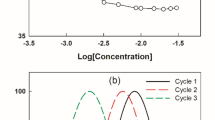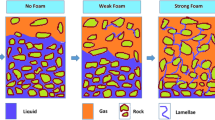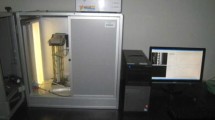Abstract
In the development of new detergent products, it is important to test the foaming behavior of different types of surfactants. Different types and concentrations of surfactant solutions prepared with three types of water are expected to present differences in their foamability. In this study, foam volumes produced by cetyl trimethyl ammonium bromide (CTAB; C19H42BrN), Tween 80® (T80; C64H124O26) and sodium dodecylsulfate (SDS; C12H25NaO4S) aqueous solutions (0.5, 1.0 and 1.5%, w/v) were compared using a stirring system, rotating at 8,000, 9,500 and 13,500 rpm. The foamability produced by CTAB, SDS and T80 solutions, in a concentration range between 0.2 and 1.0% (w/v), prepared using deionized, hard and hypersaline water were also compared. Foam volumes were higher at a stirring speed of 9,500 rpm than at 8,000 rpm. However, the results obtained at 9,500 and 13,500 rpm were not significantly different. In general, SDS solutions produced higher foam volumes than CTAB and T80 solutions. Water characteristics did not seem to influence significantly the foamability of the three types of surfactants in the studied concentrations. These studies related with foaming behavior appear to be an important step in the pre-formulation of detergent products, particularly in cosmetics and pharmaceutics.


Similar content being viewed by others
References
Saint-Jalmes A, Durian DJ, Weitz DA (2005) Foam. In: Kirk-Othmer RE (eds) Kirk-Othmer encyclopedia of chemical technology, vol 12, pp 1–28
Physics and Astronomy Department, University of California, Los Angeles Foam. http://www.physics.ucla.edu/~dws/foam.html. Accessed Nov 2004
Bikerman JJ (1973) Foams. Springer, New York
Wilson AJ (1996) Experimental techniques for the characterization of foams. In: Prud’Homme RK, Khan SA (eds) Foams: theory, measurements, and applications, surfactant science series, vol 57. Marcel Dekker, New York, pp 243–274
Huang D, Nikolov A, Wasan D (1986) Foams: basic properties with applications to porous media. Langmuir 2:672–677
Ross S (1947) Foaming volume and foam stability. NACA-tn-1153, University of Stanford
Pandey S, Bagwe RP, Shah DO (2003) Effect of counterions on surface and foaming properties of dodecyl sulfate. J Colloid Interface Sci 267:160–166
Shrestha LK, Acharya DP, Sharma SC, Aramaki K, Asaoka H, Ihara K, Tsunehiro T, Kunieda H (2006) Aqueous foam stabilized by dispersed surfactant solid and lamellar liquid crystalline phase. J Colloid Interface Sci 301:274–281
Joseph DD (1997) Understanding foams and foamability. J Fluids Eng 5:1–8
Kibbe AH (2000) Handbook of pharmaceutical, excipients. American Pharmaceutical Association and the Washington DC and Pharmaceutical Press, London
Author information
Authors and Affiliations
Corresponding author
About this article
Cite this article
Amaral, M.H., das Neves, J., Oliveira, Â.Z. et al. Foamability of Detergent Solutions Prepared with Different Types of Surfactants and Waters. J Surfact Deterg 11, 275–278 (2008). https://doi.org/10.1007/s11743-008-1088-0
Received:
Accepted:
Published:
Issue Date:
DOI: https://doi.org/10.1007/s11743-008-1088-0




